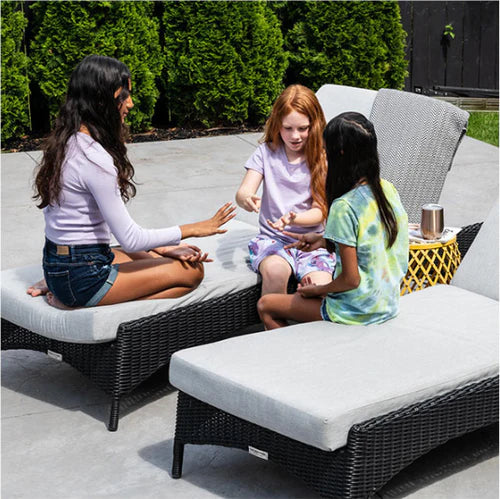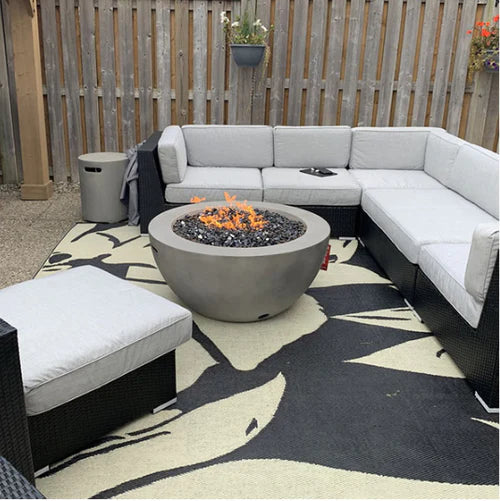As the winter season approaches, it's crucial to take the necessary steps to protect your outdoor furniture from the harsh elements. Proper maintenance and care during this time will not only ensure the longevity and beauty of your furniture but also save you from the inconvenience and expense of repairs or replacements. Winterizing your outdoor furniture involves a series of essential tips and techniques, including cleaning, covering, and storing, that will shield it from the cold, snow, and moisture that winter brings.
During the winter months, outdoor furniture is exposed to a variety of challenges that can cause damage and deterioration. Freezing temperatures, snow, ice, and fluctuating humidity levels can take a toll on even the sturdiest materials. Wood can warp or crack, metal can rust, and cushions and fabrics can become moldy or mildewed if not properly protected. Therefore, it's crucial to be proactive and prepare your outdoor furniture for the winter season.
In this comprehensive guide, we will walk you through the necessary steps to effectively winterize your outdoor furniture. We'll delve into the importance of winterizing, the benefits of proper maintenance and care, and provide you with practical advice on cleaning, covering, and storing techniques. By following these guidelines, you can ensure that your outdoor furniture remains in optimal condition and ready for use when spring arrives.
Taking the time to winterize your outdoor furniture not only preserves its aesthetic appeal but also safeguards its structural integrity. By implementing the recommended maintenance practices, you can prevent issues such as rotting, cracking, fading, and rusting, which can significantly diminish the lifespan and functionality of your furniture.
Whether you have a cozy patio set, a dining ensemble, or a collection of lounge chairs, the same principles of furniture maintenance and care apply. Regardless of the material or style of your outdoor furniture, the steps for winterizing remain largely the same. By investing a little time and effort now, you can enjoy the benefits of well-preserved furniture and be ready to fully enjoy your outdoor space as soon as the warmer months return.
So, let's dive into the details of each step involved in winterizing your outdoor furniture. From cleaning to covering and storing, we'll provide you with expert advice and practical tips to ensure that your furniture remains protected throughout the winter season. Get ready to embrace the peace of mind that comes with knowing your outdoor furniture is safeguarded and ready to provide you with comfort and enjoyment for years to come.
Section 1: Understanding the Importance of Winterizing Your Outdoor Furniture
As the winter season approaches, it's crucial to recognize the significance of winterizing your outdoor furniture. In this section, we will explore the reasons why winterizing is essential, the potential impact of winter on your furniture, and the numerous benefits of proper maintenance and care during the colder months. By understanding the importance of winterizing, you can protect your investment and ensure that your outdoor furniture remains in excellent condition year after year.
The Impact of Winter on Outdoor Furniture:
Winter brings harsh weather conditions that can have a detrimental effect on outdoor furniture. Exposure to freezing temperatures, snow, ice, and moisture can lead to several issues, including:
- Moisture Damage: Excessive moisture can cause wood to rot, metal to rust, and cushions to develop mold and mildew. The freeze-thaw cycle can further exacerbate these problems, leading to cracking, warping, or disintegration of materials.
- Fading and Discoloration: Intense sunlight during winter can cause fading and discoloration of fabrics, plastics, and paints, affecting the overall aesthetics of your furniture.
- Structural Integrity: The expansion and contraction of materials due to temperature fluctuations can weaken the structural integrity of your furniture, leading to loose joints, broken frames, or bent metal.
- Pest Infestation: Unprotected furniture can become a breeding ground for pests during winter, as they seek shelter from the cold. Insects, rodents, and other critters can cause damage to furniture upholstery, cushions, and frames.
Why Winterizing is Necessary for Protecting Your Investment:
Properly winterizing your outdoor furniture is crucial for preserving its longevity and protecting the investment you've made. By taking proactive steps to shield your furniture from the harsh winter elements, you can:
- Extend Lifespan: Winterizing helps prevent damage and wear, allowing your furniture to maintain its quality and functionality for years to come.
- Avoid Costly Repairs or Replacement: By taking preventive measures, you can reduce the risk of extensive damage that may require costly repairs or necessitate the need for new furniture altogether.
- Preserve Aesthetics: Winterizing helps to maintain the visual appeal of your outdoor furniture, ensuring that it remains attractive and inviting for the next outdoor season.
- Save Time and Effort: By investing time in winterizing your furniture, you can save yourself the hassle of dealing with extensive cleaning, repairs, or replacements in the spring.
Benefits of Proper Maintenance and Care During Winter:
Implementing a winterization routine for your outdoor furniture offers several benefits, including:
- Protection Against Moisture Damage: By covering and storing your furniture in a dry area or using waterproof covers, you can prevent moisture from seeping into the materials and causing damage.
- Preservation of Structural Integrity: Taking steps to secure and stabilize your furniture during winter can help maintain its structural integrity, preventing issues like warping or loosening of joints.
- Prevention of Fading and Discoloration: Using UV-resistant covers or storing furniture in a shaded area can protect against the harmful effects of sunlight, preserving the vibrancy of colors and preventing discoloration.
- Pest Prevention: Properly cleaning and covering your furniture can deter pests from nesting or causing damage during the winter months.
- Ease of Spring Readiness: By winterizing your furniture, you'll be ahead of the game when spring arrives. With minimal cleaning and maintenance, your furniture will be ready for outdoor enjoyment as soon as the weather permits.
Section 2: Cleaning Your Outdoor Furniture for Winter
As the winter season approaches, it's essential to prepare your outdoor furniture for the colder months by giving it a thorough cleaning. In this section, we will guide you through the necessary steps to clean your furniture, including preparing for the cleaning process, choosing the right cleaning products and techniques, addressing specific materials such as wood, metal, and wicker, and effectively removing stains and debris. By following these cleaning guidelines, you can ensure that your outdoor furniture is well-maintained and protected during winter.
Preparing Your Furniture for Cleaning:
Before you begin the cleaning process, it's important to prepare your furniture appropriately:
- Clear the Area: Remove any cushions, accessories, or debris from the furniture to create a clear and accessible surface.
- Read Manufacturer's Instructions: Consult the manufacturer's instructions or care guide for specific cleaning recommendations tailored to your furniture.
- Check for Damage: Inspect your furniture for any signs of damage, such as loose screws, cracked wood, or rusted metal. Address these issues before proceeding with the cleaning process.
- Test Cleaning Products: If you are using new cleaning products, it's advisable to test them on a small, inconspicuous area of the furniture to ensure they do not cause any adverse reactions or discoloration.
Choosing the Right Cleaning Products and Techniques:
Selecting the appropriate cleaning products and techniques is essential for maintaining the integrity of your outdoor furniture:
- Mild Soap Solution: For most materials, a mixture of mild soap and water is sufficient for regular cleaning. Avoid using harsh chemicals or abrasive cleaners that can damage the furniture.
- Specialty Cleaners: Certain materials, such as metal or wicker, may benefit from specialized cleaners designed for their specific needs. Consult the manufacturer's recommendations or seek advice from a knowledgeable professional.
- Soft Bristle Brush: Use a soft-bristle brush or sponge to gently scrub the furniture, removing dirt, stains, and grime. Avoid using abrasive brushes or scouring pads that can scratch the surface.
- Pressure Washer Caution: If you choose to use a pressure washer, exercise caution and use the lowest setting to prevent damage to the furniture. Maintain a safe distance and avoid directing the stream of water directly at joints or delicate areas.
Cleaning Different Types of Outdoor Furniture Materials:
Different outdoor furniture materials require specific cleaning approaches to maintain their appearance and longevity:
- Wood: To clean wooden furniture, start by removing loose debris with a soft brush or cloth. Wipe the surface with a damp cloth or sponge using a mild soap solution. Rinse thoroughly and allow the wood to dry completely before applying a protective sealant or storing it for winter.
- Metal: For metal furniture, remove any loose dirt or rust using a brush or sandpaper. Clean the surface with a mild soap solution or a metal cleaner, following the manufacturer's instructions. Rinse thoroughly and dry completely to prevent rust formation.
- Wicker: Clean wicker furniture by gently brushing off any dirt or dust with a soft brush. Use a mild soap solution and a sponge to clean the woven strands, making sure to reach all crevices. Rinse well and allow the furniture to air dry.
Removing Stains and Debris Effectively:
Addressing stains and stubborn debris on your outdoor furniture requires additional care and attention:
- Stain Removal: Treat stains promptly by applying a suitable stain remover or a mixture of baking soda and water. Gently scrub the stained area with a soft brush or cloth, working in a circular motion. Rinse thoroughly and repeat the process if necessary.
- Mold and Mildew: To remove mold and mildew, prepare a solution of equal parts water and white vinegar. Apply the solution to the affected area and let it sit for a few minutes. Scrub the surface gently with a brush or sponge, then rinse thoroughly. Repeat the process if needed.
- Upholstery Cleaning: If your outdoor furniture has fabric or cushioned upholstery, check the manufacturer's instructions for specific cleaning recommendations. Some fabrics may be machine washable, while others require spot cleaning with a mild detergent and water.
Section 3: Covering Your Outdoor Furniture
As winter sets in, it's crucial to protect your outdoor furniture from the harsh elements by properly covering it. In this section, we will discuss the importance of covering your outdoor furniture during winter, guide you in selecting the appropriate covers for different furniture pieces, provide techniques for covering and securing your furniture, and share additional tips for protecting cushions and upholstery. By taking these measures, you can ensure that your outdoor furniture remains in optimal condition and ready for use when warmer weather returns.
The Significance of Covering Outdoor Furniture During Winter:
Covering your outdoor furniture is essential for safeguarding it against the damaging effects of winter weather:
- Protection from Moisture: Covers act as a barrier, preventing moisture from seeping into the furniture and causing warping, rotting, or mold and mildew growth.
- Preventing Rust and Corrosion: Metal furniture is particularly susceptible to rust and corrosion when exposed to winter precipitation. Covers shield metal surfaces, reducing the risk of damage.
- UV Protection: Covers provide an extra layer of defense against harmful UV rays, which can fade and degrade materials over time.
- Keeping Furniture Clean: By covering your outdoor furniture, you can minimize the accumulation of dirt, debris, and bird droppings, reducing the need for extensive cleaning when spring arrives.
Selecting the Appropriate Covers for Different Furniture Pieces:
Choosing the right covers for your outdoor furniture ensures a proper fit and effective protection:
- Measure Your Furniture: Before purchasing covers, measure the dimensions of your furniture to ensure a snug fit. Consider the shape and size of each piece, including tables, chairs, loungers, and other accessories.
- Weather-Resistant Materials: Look for covers made from durable, weather-resistant materials such as polyester, vinyl, or specially treated fabrics. These materials provide reliable protection against moisture, UV rays, and other outdoor elements.
- Breathability: Opt for covers that are breathable, allowing air circulation to prevent the formation of mold and mildew. Look for covers with vents or mesh panels to facilitate proper airflow.
- Custom or Universal Covers: Depending on your furniture's size and shape, you can choose between custom-made covers tailored to fit specific pieces or universal covers that accommodate a range of furniture sizes.
Proper Techniques for Covering and Securing Furniture:
Covering your outdoor furniture requires careful attention to ensure a secure and effective fit:
- Clean and Dry: Before covering your furniture, make sure it is clean and dry to prevent the growth of mold or mildew. Remove any cushions, pillows, or accessories and store them in a dry place.
- Start with Larger Pieces: Begin by covering larger furniture pieces such as tables and sofas, ensuring that the covers fully enclose the furniture.
- Secure with Straps or Ties: Use straps, ties, or drawstrings to secure the covers tightly around the furniture. This helps prevent wind from lifting the covers and ensures a snug fit.
- Consider Supports: For furniture with removable cushions, consider using supports or placing them upright to maintain their shape and prevent moisture accumulation.
Additional Tips for Protecting Cushions and Upholstery:
Cushions and upholstery require special care to withstand winter conditions:
- Remove and Store Cushions: If possible, remove cushions and store them indoors during the winter. Alternatively, use cushion storage bags or dedicated storage boxes to keep them clean and dry.
- Use Waterproof Covers for Cushions: If leaving cushions outdoors, use waterproof covers specifically designed to protect them from moisture and dirt.
- Upholstery Protection: Apply a fabric protector or water-repellent spray to upholstered surfaces, following the manufacturer's instructions. This extra layer of protection can help repel water and prevent stains.
By implementing the proper maintenance and care techniques discussed in this article, you can effectively protect your outdoor furniture during the winter months. Winterizing your furniture will not only extend its lifespan but also ensure that it remains in excellent condition for future use. Remember to clean your furniture, cover it properly, and store it in a suitable location. Additionally, consider weatherproofing methods and address any specific challenges your furniture may face. By following these essential tips and techniques, you can enjoy beautiful and durable outdoor furniture year after year.
Remember, your outdoor furniture is an investment, and taking the time to care for it during winter will pay off in the long run. So, don't neglect the importance of furniture maintenance and care. Start preparing your outdoor furniture for winter today and enjoy the benefits of well-preserved and protected pieces when the warmer months return.














